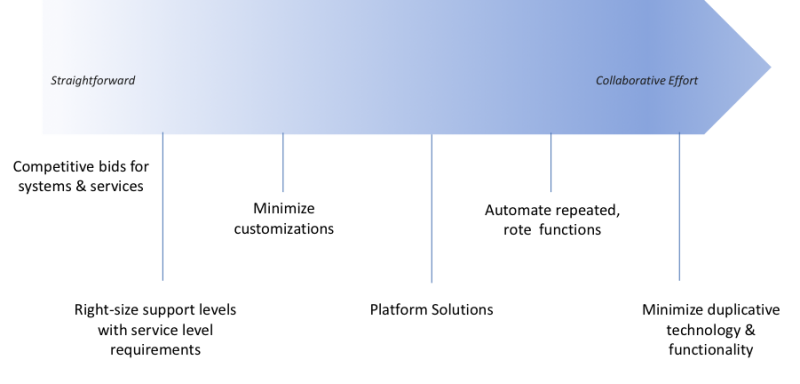CIOs and the Healthcare Cost Curve
April 10, 2015
For the last decade, CIOs have been laser-focused on implementing and gaining adoption of electronic health records. Now that the “meaningful use” threshold has been crossed, the focus for many CIO’s is making this data accessible and actionable.
As part of this shifting role, CIOs must also become more aligned with the strategic priorities of their colleagues in the C-Suite—and in the “post-EHR era” that means focusing on cost improvement. According the annual ACHE survey, for the 11th year in a row, “Financial Improvement Challenges” tops the list of CEO concerns. Not surprisingly, it also tops the list for CFOs, according to several recent surveys.
While CIOs haven’t traditionally been financially focused, they are now key players in the cost improvement conversation. Why? The CIO has the ability to get actionable data in the hands of end users; the CIO is the fuel that gives energy to cost and quality improvement initiatives. In fact, if CIOs are not viewing their role in this way, the organization is undoubtedly not realizing all of the savings available.
The CIO has two vital responsibilities specific to driving out costs: stewardship of the organization-wide IT spend and enabling cost savings initiatives to produce real savings.
Stewardship of the IT spend
As healthcare providers become increasingly technology enabled, the opportunities to spend more money on systems, implementation, maintenance fees, networks, and consultants are endless. There is always something newer, faster, better than what an organization just bought and painstakingly installed. And, of course, most have a strong return on investment (ROI)—on paper, anyway.
The speed of change combined with the relentless need to meet end users’ needs can be maddening. Without strong data governance structures to ensure that systems are well coordinated and functionality does not overlap, the IT stack can quickly become fraught with duplicative systems and fees – read excess cost.
For many years, healthcare organizations have looked to front line departments that have large staffs and use expensive supplies to generate cost savings. After years of cost reduction in these areas, the savings that can be generated today is likely less. To generate the level of cost savings needed, organizations must look beyond the front line operations to find savings.
The CIO should be leading the charge within his or her division to reduce the cost of the IT operations without sacrificing speed, access, quality of data, or functionality.
As shown in exhibit 1, CIO-related cost savings opportunities run the continuum from straightforward, ‘just do it’ actions to the more complex initiatives that require cross-functional collaboration and well-defined processes and structures.
Exhibit 1
Enabling cost savings throughout the organization
In addition to reducing the organization’s IT expenses while delivering increased functionality, it is equally important for the CIO to partner with operational, clinical and financial leaders as they work to identify and implement cost savings opportunities. Doing so will accelerate and strengthen the organization’s ability to respond to market changes, improve quality, and decrease costs.
Promoting Self-Service Access to Actionable Information
Getting useful, drillable, actionable data into the hands of decision-makers is the most important and impactful endeavors a CIO can take on in an organization. When end users have to go through gatekeepers of information to get data they need, the pace of change slows dramatically and often coming to a complete standstill. Up until the past three to five years, these gatekeepers were instrumental in the improvement process because accessing large amounts of data in most systems required deep expertise in writing queries and understanding data structures.
However, with the introduction of more user-friendly decision support systems and presentation layer software that sits on top of an electronic data warehouse (EDW), many end users can competently access the data they need to make decisions without gatekeeper assistance.
Continuing to operate in an environment where users have to put in data requests and wait is not only frustrating for all stakeholders but also can prevent end users from diving into the data because it is simply too hard and time consuming to jump through the hoops. In our technology savvy world, staff members without “gatekeeper” level skills are very capable of navigating user-friendly systems to get the information.
The CIO’s role is to provide the portal for the end users to access self-service data sources and analytical tools that produce accurate and actionable information. Making this a reality, along with a robust training, rollout, and support plan will make an organization more nimble, data-driven, and action oriented on metrics that matter.
Leveraging the right technology for cost improvement
As CIO’s look towards the future and consider how they can make a positive impact, their number one focus should be on expediting the flow of meaningful information into the hands of those that need to make decisions—not just clinical leaders but also financial and operational.
We know for sure that the technology is there to take healthcare to the next level—to make it more efficient, more predictable, more personalized, and more automated. It is the responsibility of the CIO to lead the organization forward in this post-EHR era to a brighter future where healthcare is not only more effective but also more sustainable for many years to come.
